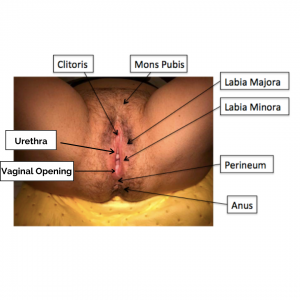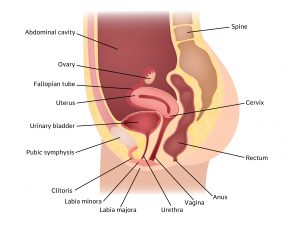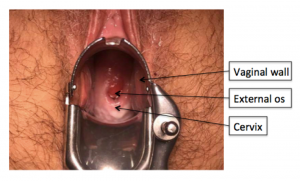Mykenzie Mattheis, DO and Ellen R. Solomon, MD
Pelvic and Genital Anatomy_FFHA2019
What exactly is “down there”?
Pelvic and genital anatomy is made up of external and internal structures. External structures together are called the vulva. The internal anatomy are the vagina and reproductive organs.
What is the vulva?
The external structures combined together make up the vulva. These include:
- Mons pubis: The round fat pad over the bone between the thighs called the pubic symphysis.
- Labia minora and majora: The labia majora are fatty skin folds below the mons pubis. Labia majora have hair and are larger. Labia minora are skin folds that lie between the majora, have no hair, and form the opening to the vagina. The size and shape of labia vary from person to person.
- Clitoris: This is the most sensitive area of the external anatomy. It is the erectile tissue with many nerve endings. A large part of the clitoris is hidden under the clitoral hood.
- External glands: There are two Bartholin glands that are located near the opening of the vagina. They make a clear, whitish mucus that may lubricate the outer vagina and vulva. There are also Skene’s glands located on either side of the urethra opening. Their exact function is not completely understood; it is possible that they play a role in female sexual arousal.
- Perineum: The area between the anus and the vagina. The perineum is connected to the lower pelvic floor muscles and helps support the outer vagina. This is an area that may tear during a normal vaginal delivery.
 How many “holes” are down there?
How many “holes” are down there?
Three! Take a mirror and look at your vulva. The first small opening closest to the front of the body is called the urethra. The urethra is connected to the bladder and is the passage for urination. The next opening is the vagina. Finally, the third opening is the anus and is the passage for stool.
What are the reproductive organs?
The reproductive organs include the uterus, cervix, vagina and adnexa (tubes and ovaries).
 What is the function of the uterus?
What is the function of the uterus?
The uterus is located deep in the pelvis behind the bladder. The role of the uterus is to nourish a fertilized embryo and developing fetus. The uterus is made up of two main layers of tissue, the myometrium and the endometrium. The myometrium is the outer layer of muscle of the uterus. It is responsible for contractions during labor and menstrual cramps. The endometrium is a specialized tissue inside the cavity of the uterus. It has cycles of growth and shedding. It is responsible for bleeding with each menstrual cycle and is the home for a fertilized egg.
What are the adnexa?
The ovaries and fallopian tubes together make up the adnexa. The fallopian tubes connect the ovaries to the uterus. When an egg, called an ovum, is released from the ovary it travels through the fallopian tube. Sperm travel up through the vagina and uterus to meet the egg in the fallopian tube. The part of the fallopian tube closest to the uterus is a common site for an egg to become fertilized.
What is the function of ovaries?
During the reproductive years the ovaries produce hormones called estrogen and progesterone. These hormones work to develop female sex characteristics such as breasts and pubic hair, produce eggs, and maintain early pregnancies.
What is the cervix?
The cervix is a tube-like structure that connects the uterus and the vagina. It is about 1.5 inches in length and has a small opening into the cavity of the uterus. At the end of pregnancy the cervix thins and widens to allow for delivery of the baby.
What is the vagina?
The vagina is located in between the bladder and the rectum. It is a flattened tube that extends from the opening of the labia minora to around the cervix. Menstrual blood passes through the vagina, and the vagina expands to deliver a baby. The average adult size of the vagina is about 3-4 inches in length.
What is the best way to keep genitals clean?
To clean external genitals, always wipe front to back. This helps prevent bacteria from entering the urethra and causing a urinary tract infection. For cleaning, use only unscented soaps and toilet paper. Scented products can contain chemicals that can irritate the skin and cause itching or burning. Water alone is enough for cleansing the vulva. It is best to wear clothing that allows air to circulate around the vulva. This means avoiding tight clothing and wearing cotton-lined under garments.
The vagina is self-cleaning. Vaginal fluid is normal and helps keep the vagina healthy, unless pain or unpleasant odor are present. Do not douche. Douching washes away the protective bacteria in the vagina, which can increase the risk for infection. Avoid scented pads or tampons. Avoid vaginal perfumes or deodorants. Scented products can contain chemicals that can irritate the vagina. They can cause itching or burning of the vagina.
What does my doctor see with a speculum exam?
The speculum exam is used to examine the vagina and cervix. The external os is the opening of the cervix that goes into the uterus; this is where the baby comes out when the cervix dilates with labor! If a patient has had a hysterectomy, or removal of the uterus, then the speculum is used to see the vaginal cuff. This exam can help find pelvic organ prolapse or any lesions or cysts in the vagina and cervix, including those that may be suspicious for cancer.
 What is a Pap smear? What is it for?
What is a Pap smear? What is it for?
A Papanicolaou, or Pap smear, is usually done at the same time as a speculum exam for people with vaginas who are ages 21-65 years old. It is a test to look at the cells in and around the cervix to see if there are any changes that could be pre-cancer or cancer. Depending on their age, a person may also have an HPV test. HPV is a virus that is the most common cause of cervical cancer. Having regular Pap smears can help prevent cervical cancer by catching early changes in the cells. Today we have a vaccine for the HPV virus that also helps reduce the risk of cervical cancer.
What is a bimanual pelvic exam? What is it for?
The bimanual pelvic exam gives a healthcare provider information about the vagina, cervix, uterus and ovaries. During the exam the caregiver feels for masses in the vagina and pelvis and the size, shape and position of the uterus. Infection or other problems may be suspected if the exam is extremely uncomfortable.
Author Information

Mykenzie Mattheis is an Ob/Gyn resident at Aurora Health Care in Milwaukee, Wisconsin. Her interests include sexual health education, women’s health advocacy, global health, and medical education development. No conflicts of interest to report.

Ellen R. Solomon is a female pelvic medicine and reconstructive surgeon at Baystate Medical Center in Springfield Massachusetts. She is an assistant professor in Obstetrics and Gynecology for the University of Massachusetts medical school. Her interests include pelvic floor health, menopause, sexual health, minimally invasive surgery and management of prolapse and incontinence. Dr. Solomon also works with Genneve but has no other conflicts.






